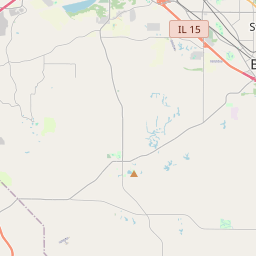Palmier Cemetry
Historical marker location:
265 Quarry Rd, Columbia, Illinois
( Memorial can be reached from Palmer Road, 0.3 miles north of Quarry Road, on the right when traveling north.)
Marker installed: 1976







© OpenStreetMap contributors
Loading...
Searching for other points of interest within 3 miles of this location.The state of Illinois played a crucial role in the Underground Railroad, a network of secret routes and safe houses used by slaves to escape to freedom in the 19th century. Many abolitionists in Illinois provided safe houses for escaping slaves, and Chicago was a key hub on the Underground Railroad.
About Monroe County
Monroe County Timeline
Monroe County, Illinois has a rich and fascinating history that dates back to the early 1800s. The county was officially established in 1816 and was named in honor of James Monroe, the fifth president of the United States. The area has a strong German heritage, as many German immigrants settled here in the mid-19th century.
The early years of Monroe County were marked by small, agrarian communities and the development of infrastructure such as roads and schools. The county became a popular destination for settlers looking for fertile farmland and a peaceful way of life. Agriculture played a vital role in the county's economy, with crops such as corn, wheat, and tobacco being grown.
During the mid-19th century, Monroe County experienced significant growth and development. The arrival of the railroad in the 1850s opened up new opportunities for trade and commerce. The county seat, Waterloo, became a hub for businesses and attracted residents from surrounding areas. The growth of industry and commerce brought about the need for better transportation and infrastructure systems, leading to the construction of bridges and roads.
Monroe County has also witnessed its fair share of historical events. During the Civil War, the area was divided in terms of allegiance, with some residents supporting the Union and others supporting the Confederacy. The county saw skirmishes and troop movements, and its citizens played an active role in the war effort. In the early 20th century, the county faced challenges such as the Great Depression and World War II, but managed to rebuild and adapt to changing times.
Today, Monroe County continues to thrive as a vibrant community that embraces its history while looking toward the future. Its charming small towns, picturesque landscapes, and strong sense of community make it a wonderful place to live and visit.
The early years of Monroe County were marked by small, agrarian communities and the development of infrastructure such as roads and schools. The county became a popular destination for settlers looking for fertile farmland and a peaceful way of life. Agriculture played a vital role in the county's economy, with crops such as corn, wheat, and tobacco being grown.
During the mid-19th century, Monroe County experienced significant growth and development. The arrival of the railroad in the 1850s opened up new opportunities for trade and commerce. The county seat, Waterloo, became a hub for businesses and attracted residents from surrounding areas. The growth of industry and commerce brought about the need for better transportation and infrastructure systems, leading to the construction of bridges and roads.
Monroe County has also witnessed its fair share of historical events. During the Civil War, the area was divided in terms of allegiance, with some residents supporting the Union and others supporting the Confederacy. The county saw skirmishes and troop movements, and its citizens played an active role in the war effort. In the early 20th century, the county faced challenges such as the Great Depression and World War II, but managed to rebuild and adapt to changing times.
Today, Monroe County continues to thrive as a vibrant community that embraces its history while looking toward the future. Its charming small towns, picturesque landscapes, and strong sense of community make it a wonderful place to live and visit.
Monroe County Timeline
This timeline provides a condensed summary of the historical journey of Monroe County, Illinois.
- 1722 - French explorer Philippe François Renault leads an expedition to the area that would later become Monroe County.
- 1802 - The United States acquires the region as part of the Louisiana Purchase.
- 1816 - Monroe County is founded and named after President James Monroe.
- 1820 - The first courthouse is constructed in Waterloo, the county seat.
- 1825 - The original county boundaries are established.
- 1829 - The Illinois General Assembly grants a charter for the construction of the Illinois and Michigan Canal, which would pass through Monroe County.
- 1831 - The first steamboat arrives in Waterloo, marking the beginning of its importance as a river port.
- 1862 - The county experiences significant Civil War activity, including the Battle of Fort de Chartres.
- 1873 - The first railroad is completed in the county.
- 1918 - Lewis Bridge, the longest highway bridge in Illinois, is constructed.
- 1950 - The population of Monroe County exceeds 20,000.
- 2010 - The population reaches over 32,000.